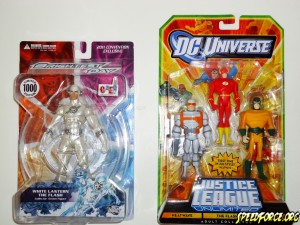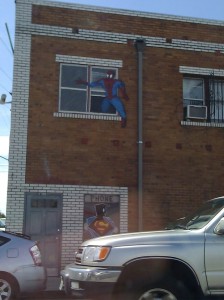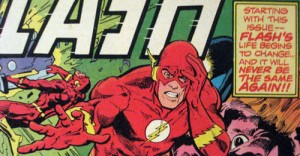So last weekend Chicago’s biggest comic book convention, C2E2 was held. Which just so happens to be the the first leg on the Mattycollector.com Collector Appreciation Tour 2011. This is the first place they would be selling the Heatwave, Flash and Mirror Master set, amongst other JLU goodies. Now normally I would be sitting back looking at the trickle of toy news online and thinking about how much the figures are going to cost me on evilBay the next day. This time however I had an ace in the hole; a reader of Speed Force who frequently posts comments under the name Fastest, Mark Maslauskas. Mark was going to the convention and was kind enough to offer to pick up a set for me. Can you believe it? Absolutely awesome.
On the Value of Relaunches
More importantly, the more DC has to promote the next Flash #1, the less it has [available] to devote to (let’s just say) hyping a new Icon series. If DC would put some of its series on hiatus, as opposed to cancelling one volume so a new one can begin a few months later, it would acknowledge the reality of cancellation-proof series and let more attention linger on the stragglers. Who knows — given time, maybe some of them could become cancellation-proof too.
— Robot 6’s Tom Bondurant in his Grumpy Old Fan column.
As he points out, The Flash is one of DC’s “foundational” series, which have been in almost continuous publication since the Silver Age. We all know it’s coming back.
Flash #11 Variant Cover by Scott Kolins
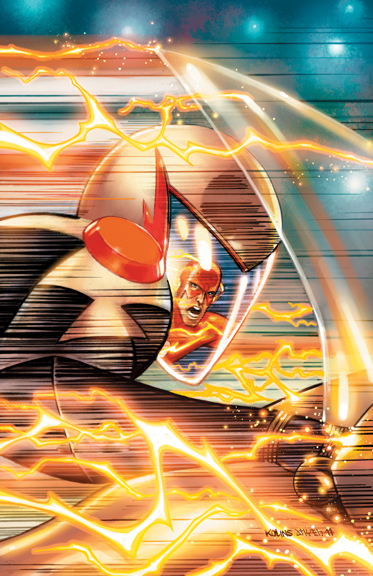
DC has released seven covers over at The Source today, including this Scott Kolins piece for the upcoming Flash #11, due at the end of April.
On a related note, Flash #10 is scheduled for April 13, featuring the Francis Manapul cover originally set for #9 and a Yildiray Cinar variant.
Speed Reading
I spent the weekend moving to a new city, so posting’s a bit light. Here’s the round-up of last week’s linkblogging.
First, the Flashy links:
- New Flash forum: The Fastest Forum Alive
- Comics Nexus asks of Flashpoint, Where Is Wally West?
- Comics Nexus considers: Is Geoff Johns leaving The Flash for his new Aquaman series?
- That F’ing Monkey reviews McDonalds’ Kid Flash & Captain Cold Happy Meal toys
And the rest.
- Local Comic Shop (LCS) Etiquette Tips from Secret Headquarters: Part 1, Part 2 (via @johannadc at Comics Worth Reading)
- The Problem with the New Teen Titans (The Cool Kidz Table)
- Two pieces on Lois Lane: Lois Lane Needs Her Own Comic Book Series, As Superwoman (Geekscape) and Dean Trippe’s proposal for a series of young adult novels, Lois Lane, Girl Reporter.
- Photo of a building I drove past recently. Do you think there might be a comic store in there?
- Tom Bondurant concludes his look at DC’s ongoing series since COIE at Grumpy Old Fan. It’s interesting to see which ones have lasted the longest. #1 is Hellblazer. #2 is The Flash (Wally West).
Read THE FLASH #1 Online for Free!
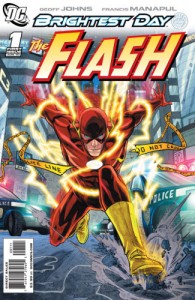 ComiXology now has the first two issues of The Flash vol.3 available as digital comics for their online reader or iOs/Android apps. (Sadly, the joke about having Flash on the iPad has been completely played out by now.) Better yet: The first issue is available for free!
ComiXology now has the first two issues of The Flash vol.3 available as digital comics for their online reader or iOs/Android apps. (Sadly, the joke about having Flash on the iPad has been completely played out by now.) Better yet: The first issue is available for free!
The online version works fairly well, except for trying a bit too hard to imitate the printed comic look. (Please, we don’t need those gradients imitating the curved paper near the spine — especially on double-page spreads!) The phone app has a few problems adapting the art to the smaller screen size. I will say that this issue (at least the part I skimmed — it’s a busy day!) works better when viewed landscape than portrait.
Keep in mind: if you’re browsing the ComiXology store for these, they’re currently sorted under “T” for The Flash.
» The Flash: Rebirth
» The Flash vol.3
(via Francis Manapul’s Twitter.)
Annotations – Trial of the Flash: Introduction and Issue #270
Welcome to the first installment in our analysis of the soon-to-be-reprinted “Trial of the Flash”, and related Flash storylines!
Arguably the most praised and vilified pre-Crisis Flash tale, the Trial story was written by Cary Bates, began in 1983 and ran through the title’s cancellation in 1985. With seeds in stories from as far back as 1979, the Trial was essentially the collision of years of Flash plot threads. These stories are some of the earliest examples of long-form, soap-opera style writing in DC Comics.

